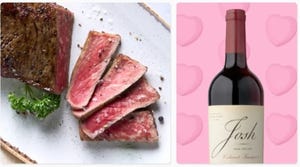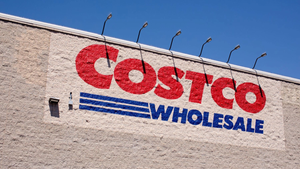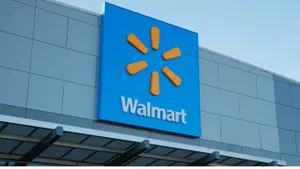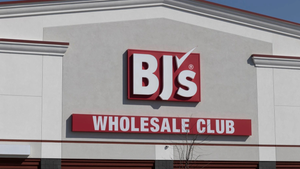SPLENDA'S SUCCESSSPLENDA'S SUCCESS
Most retailers have a sweet tooth when it comes to Splenda.That's because the sweetener has been a boon not only to products that contain it, but also to the sugar substitute category.Dollar sales of sugar substitutes increased 6.7% to $320 million in food stores for the 52 weeks ending March 20, according to Information Resources Inc., Chicago.Splenda No Calorie Sweetener had a lot to do with that.
May 23, 2005
Carol Angrisani
Most retailers have a sweet tooth when it comes to Splenda.
That's because the sweetener has been a boon not only to products that contain it, but also to the sugar substitute category.
Dollar sales of sugar substitutes increased 6.7% to $320 million in food stores for the 52 weeks ending March 20, according to Information Resources Inc., Chicago.
Splenda No Calorie Sweetener had a lot to do with that. Dollar sales of the No. 1 sugar alternative soared 34% to $167 million in food stores for the same period. This came at a time when sales of the other top 5 brands fell, several in the double digits. White granulated sugar dollar sales slipped 4.6% to $802 million.
"[Splenda] has eaten into sales of other sugar substitutes," said Gus Lebiak, director of grocery merchandising, Foodtown, Carteret, N.J.
Nearly half of shoppers are looking for products with less sugar, according to Grocery Manufacturers of America. Accordingly, Splenda has gained wide appeal among dieters, diabetics and those who feel it's a healthier sugar substitute.
Plus, Splenda's tolerance for heat may encourage consumers who avoided baking with sugar to use it in cookies and cakes, according to research firm Mintel International Group, Chicago.
Splenda is the brand name for sucralose, a no-calorie sweetener made from sugar through a process that replaces three hydrogen-oxygen groups on the sugar molecule with three chlorine atoms. This process prevents sucralose from being metabolized by the body for energy, making it calorie-free.
About 4,000 products worldwide have Splenda as an ingredient, including packaged goods, carbonated soft drinks and ice cream that are marketed as sugar-free or reduced sugar. Beverage marketers have been particularly supportive, so much so that they have swapped Splenda for other sweeteners in their diet drinks. Most recently, Coca-Cola announced the launch of Diet Coke sweetened with Splenda (Coca-Cola will continue to market regular Diet Coke); Pepsi-Cola is adding the sweetener to the newly reformulated Pepsi ONE; and Cadbury Schweppes Americas Beverages is rolling out a reformulated Diet 7UP sweetened with it.
"Splenda seems to be the miracle ingredient of the beverage industry," said Valerie Skala Walker, vice president, analytic product manager, IRI.
As a result of McNeil's aggressive brand-extension efforts, the sweetener has become much more visible on supermarket shelves since it first became available at retail in 2000. Last year, McNeil launched Splenda Sugar Blend for Baking, a mix of Splenda and pure sugar that carries a suggested retail price of $6.29 to $6.49 for a two-pound bag. Splenda Brown Sugar Blend will hit the market in September, with an SRP of $4.69 for a one-pound bag.
Splenda has helped buoy the slowing sugar/sweetener industry, according to Mintel. The research firm forecasted sugar/sweetener sales to rise just 3% to $2.2 billion from 2003 to 2008. This translates into a 9% loss after adjusting for inflation. Mintel attributed this to rising interest in prepared and presweetened food and drinks.
"The factor keeping the marketing from falling farther is the strong interest in Splenda from diabetics, dieters and possibly mothers concerned about tooth decay," stated a Mintel report on the sugar/sweetener market.
Splenda's fast growth earned McNeil the Business Transformation of the Year award at IRI's Reinventing CPG & Retail summit, held in March.
McNeil Nutritionals, Fort Washington, Pa., a Johnson & Johnson company, handles Splenda's brand retail and food-service business. Tate & Lyle, London, a food and ingredient company, manufactures sucralose and is responsible for the global ingredient sales of Splenda-brand sucralose to food and beverage manufacturers.
"McNeil Nutritionals recognized early on an opportunity to bring a compelling and differentiated sweetener proposition to both consumers and retailers -- and in the process, transformed a category that has delivered relatively stagnant growth over the past decade and a half," according to an IRI statement.
Splenda's growth has spawned the introduction of other sweetener products. Take Merisant, Chicago, marketer of Equal, which has introduced Equal Sugar Lite, a lower-calorie, lower-carb sweetener that can be used to replace sugar in recipes. Unlike Splenda, Equal is sweetened with aspartame.
Along with such new-product growth, there's been more promotional support at retail as sweetener vendors have beefed up their promotional calendars to maintain market share, said Lebiak of Foodtown.
Lebiak said Splenda is a new product, not just another "me-too." As such, it has generated incremental category sales, he said.
"It's attracted people who may not have been happy with the sugar substitutes out there," said Lebiak, adding that he now takes his coffee with Splenda.
"I'm a heavy coffee drinker, so it's helped take a lot of teaspoons of sugar out of my diet," he said.
Overall sweetener sales increased 12% for the 52 weeks ending last month at Associated Grocers, a Seattle-based wholesaler, said Curt Seipert, category manager. Splenda's sales alone grew 25%.
Seipert credited much of that rise to the presence of Splenda Sugar Blend for Baking, which hit Associated's retailer store shelves in September 2004.
"There was a big [sales] turnaround during the fall baking season, when people were introduced to Splenda as a baking ingredient," he said, adding that Associated may also carry Equal's Sugar Lite this fall.
A big part of Splenda's draw is that it tastes good, is calorie-free, and appeals to many different consumer groups, Seipert said. He said he expected sales to remain strong for years due to demand from the immense baby boomer population, which will continue to seek out sugar-free products as they age.
"The low-carb movement may go away, but demand for sugar-free products won't," he said.
Splenda has lifted the category so much that Seipert has explored creating a lower-cost, private-label version under the Western Family label. McNeil has such a strong patent on the brand that Seipert isn't sure if the effort will go through, though.
Associated's retail customers -- which include Haggen, Zupan's and Market Place -- carry a variety of Splenda products. Along with Splenda Sugar Blend, selections include 200-count packets and a 9.7-ounce bag of granules.
At Save Mart Supermarkets, Modesto, Calif., Splenda commands 50% of the sugar substitute category in terms of sales and profits, and 15% of the total sugar/sweetener market, said Cathy Mondloch, grocery buyer.
Splenda Sugar Blend, in particular, has helped attract new users to the category.
"Consumers want to bake from scratch, but would prefer something that's better for their health," Mondloch said. "Splenda Sugar Blend allows them to do that."
The product's strong performance led Save Mart to revamp its sugar/sweetener promotional plans for the fall. Rather than focus on individual packets of sugar substitutes, the retailer will put the bulk of its activity into promoting Splenda Sugar Blend.
Meanwhile, the sugar industry is fighting its own declining sales with a new ad campaign that seeks to promote sugar as an all-natural ingredient. The Sugar Association planned to break a TV, radio and Internet campaign May 19 that would associate sugar with tradition and family in emotion-laden spots featuring home baking scenes.
At the same time, sugar makers are looking for ways to jazz up their brands with new product packaging designed with ease of use in mind.
Domino Sugar, Yonkers, N.Y., launched a new four-pound plastic canister designed to prevent countertop spills that can happen when traditional sugar bags are opened.
Imperial Sugar in Sugar Land, Texas, a major sugar supplier in the South and Southeast, on July 1 will introduce two new convenience-driven products. One is a five-pound bag of granulated sugar in a resealable pouch. It's also expanding its line of sugar shakers in contoured plastic bottles with a full-shrink label, designed for table use. Both will be sold under the Imperial and Dixie Crystals brands.
For all the success of Splenda, there are still some markets the sweetener hasn't penetrated.
In Charlotte, Mich., Carter's Food Centers carries Splenda Sugar Blend and will promote it during the fall baking season, but the product is not selling well, said Scott Casler, grocery buyer. In fact, the sugar substitute category as a whole is tepid.
In the case of Splenda Sugar Blend, Casler blamed the $6.29 to $6.49 SRP for a two-pound bag. "The price is a little prohibitive," he said.
As for the category's overall weakness at Carter's, Casler offered a different explanation.
"People in our area still want real sugar in their coffee," he said.
The Splenda Timeline
1976: Sucralose is discovered by scientists at Tate & Lyle PLC and researchers at Queen Elizabeth College in London.
1998: Sucralose receives FDA approval for use in 15 food and beverage categories.
1999: FDA approves sucralose for use in all food and beverage applications. Splenda becomes available to consumers via the Internet.
2000: Splenda No Calorie Sweetener is launched at grocery stores, restaurants and retail outlets.
2004: Splenda Sugar Blend for Baking is introduced.
2005: Splenda Brown Sugar Blend to roll out in September.
Source: www.splenda.com
The Splenda Squabble
FORT WASHINGTON, Pa. -- Much of the food retailing industry is embracing Splenda, but not everyone is sweet on the sugar substitute.
McNeil Nutritionals here faces a lawsuit from the Sugar Association, Washington, which seeks a nationwide injunction to prevent the company that markets Splenda from "misleading the public" about Splenda. A consumer group and trade association have criticized McNeil for what they call misleading labeling and advertising.
At issue is McNeil's use of the slogan "made from sugar, so it tastes like sugar." The Center for Science in the Public Interest, Washington, said that while the product appears to be safe, the catchphrase implies that the product is natural.
"The sucralose in Splenda is, in fact, a synthetic chemical that contains chlorine, something that no natural sugar contains," CSPI said in a statement.
Splenda is made from sugar through a process that replaces three hydrogen-oxygen groups on the sugar molecule with three chlorine atoms. This makes Splenda calorie-free and stable so it can withstand the heat from cooking and baking without losing its sweetness.
McNeil responded that more than 100 scientific studies document the safety of sucralose, the sweetening ingredient in Splenda. It, in turn, filed a court action for false advertising and deceptive trade practices against the Sugar Association; each of its members; and Qorvis Communications, a public relations firm that represents the association.
McNeil contended in the lawsuit that the association "knowingly and intentionally made false claims about Splenda that are baseless and that are designed to injure its reputation and goodwill."
About the Author
You May Also Like






